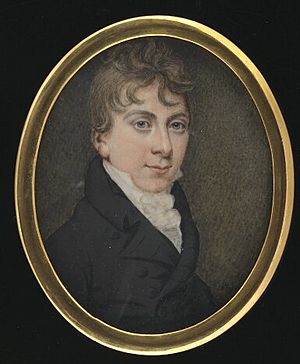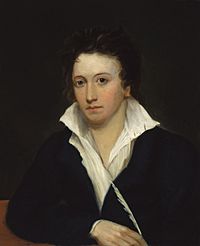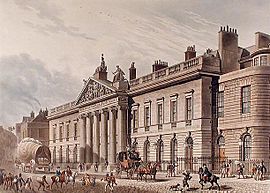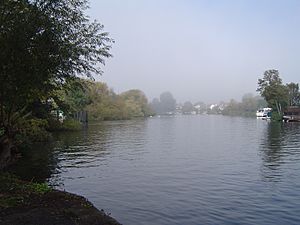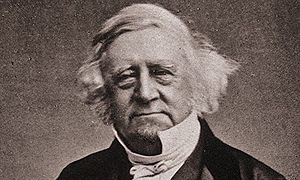Thomas Love Peacock facts for kids
Quick facts for kids
Thomas Love Peacock
|
|
|---|---|
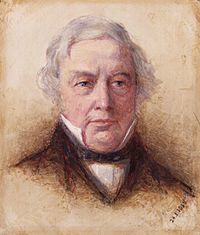 |
|
| Born | 18 October 1785 Weymouth, Dorset, England |
| Died | 23 January 1866 (aged 80) Lower Halliford, Shepperton, Surrey, England |
| Notable works |
|
| Spouse |
Jane Gryffydh
(m. 1820; died 1865) |
| Children | 4, including Edward Gryffydh Peacock |
Thomas Love Peacock (born October 18, 1785 – died January 23, 1866) was an English writer and poet. He also worked as an official for the East India Company. Peacock was a close friend of the famous poet Percy Bysshe Shelley. They both influenced each other's writing. Peacock wrote funny novels that often featured characters sitting together, discussing and debating the popular ideas of their time.
Contents
Early Life and Learning
Thomas Love Peacock was born in Weymouth, Dorset, England. His father, Samuel Peacock, was a glass merchant. His mother was Sarah Love. In 1791, Thomas moved with his mother to Chertsey to live with her family. He went to a school in Englefield Green for about six and a half years.
When he was 13, in 1798, he left school suddenly. From then on, he taught himself everything he learned. He read a lot and studied literature in Greek, Latin, French, and Italian.
First Jobs and Journeys
In 1800, Peacock started working as a clerk for a company in City of London. He lived with his mother there. He even won a prize for a poem he wrote for a magazine called "The Monthly Preceptor." He also wrote for "The Juvenile Library," another magazine for young people.
He published his first two poetry books, The Monks of St. Mark and Palmyra, in 1804 and 1806. Around 1806, he left his job and went on a walking tour of Scotland.
In 1808, he worked as a private secretary for Sir Home Popham, who commanded a fleet of ships. He later served on a ship called HMS Venerable. He didn't enjoy life at sea very much. He said it was hard to write poetry there. He left the ship in 1809.
He then wrote a poem about the River Thames called "The Genius of the Thames." In May 1809, he took a two-week trip to follow the Thames from its start to Chertsey.
In 1810, Peacock traveled to North Wales. He stayed in Maentwrog and was interested in Jane Gryffydh, a local parson's daughter. His poem "The Genius of the Thames" was published that year.
Friendship with Shelley
In 1812, Peacock met the poet Percy Bysshe Shelley. They became very good friends. Peacock wrote a long memory about Shelley later in his life. Their friendship was important for both of their careers.
In 1813, Peacock went with Shelley and his first wife, Harriet, to Edinburgh. Peacock liked Harriet very much.
After Shelley separated from Harriet, Peacock often visited Shelley and Mary Godwin (who later became Mary Shelley) in London. In 1815, Peacock joined them on a trip to the source of the River Thames.
In 1815, Peacock wrote his first satirical novel, Headlong Hall, which was published in 1816. This book showed his unique writing style, mixing funny stories with interesting poems.
Peacock and Shelley often spent time together, studying Greek. Shelley helped Peacock financially for a while. Peacock also helped Shelley with his poems. Shelley's influence can be seen in Peacock's poem Rhododaphne, published in 1818. Peacock also wrote the satirical novels Melincourt (1817) and Nightmare Abbey (1818).
When Shelley left for Italy, he and Peacock agreed to write letters to each other. This led to Shelley's wonderful descriptive letters from Italy.
Working for the East India Company
In 1819, Thomas Love Peacock got an unexpected job offer from the East India Company. This company managed trade and government in India. They needed talented people for their office. Peacock's test papers for the job were highly praised.
On January 13, 1819, he wrote that he was studying Indian affairs. He hoped this job would provide him with a good income. He found the work interesting, dealing with money and laws, and felt he could help many people.
In 1820, Peacock wrote The Four Ages of Poetry. In this essay, he suggested that poetry was becoming less important because of science. This idea made Shelley write his famous essay, Defence of Poetry.
Peacock's job at the India House delayed his novel Maid Marian, which was finally published in 1822. His salary grew, and in 1823, he bought a house in Lower Halliford, near the River Thames. He loved the river and classical literature.
Peacock was very good at his business work. In 1829, he started focusing on steam navigation. He also published The Misfortunes of Elphin, a novel based on Welsh stories, and Crotchet Castle in 1831.
In 1836, Peacock became the Chief Examiner of Indian Correspondence. This was a very important job, requiring strong business skills and excellent writing. He was known for doing a great job, just like the famous writers who held the position before and after him.
He even wrote a funny poem about his work day at the India Office:
From ten to eleven, have breakfast for seven;
From eleven to noon, think you've come too soon;
From twelve to one, think what's to be done;
From one to two, find nothing to do;
From two to three, think it will be
A very great bore to stay till four.
Around 1852, Peacock started writing more again. He wrote for Fraser's Magazine, including his memories of Shelley.
Later Years
Peacock retired from the India House on March 29, 1856, with a good pension. He mostly stayed at his home in Halliford, enjoying his books, garden, and the River Thames.
In 1860, he published his last novel, Gryll Grange. He also added an appendix of Shelley's letters to his writings. His last works were two translations.
Thomas Love Peacock passed away on January 23, 1866, in Lower Halliford. He was hurt in a fire while trying to save his library. He is buried in the new cemetery in Shepperton.
Family Life
Peacock married Jane Gryffydh in 1820. Shelley once called Jane "the milk-white Snowdonian Antelope." Thomas and Jane had four children: a son named Edward and three daughters. One of his daughters, Mary Ellen, later married the novelist George Meredith. Only his son outlived him, but Edward died less than a year later. Peacock had several grandchildren. Jane Peacock died in 1865.
His Writings
Peacock is best known as a writer of satire. This means he used humor and irony to criticize people's ideas or actions. His novels are unique because they don't focus on a strong plot or deep character feelings. Instead, they are full of smart conversations and debates.
His comedy often mixes old Gothic stories with the style of ancient Greek plays. He loved Ancient Greece, and many of his characters have names that are funny puns related to Greek words.
Peacock's novels are more about what characters say than what they do. He often wrote entire chapters as dialogues, like a play. These works are similar to ancient Greek writings where people would gather to discuss ideas while eating.
Novels
- Headlong Hall (published 1815, dated 1816)
- Melincourt (1817)
- Nightmare Abbey (1818)
- Maid Marian (1822)
- The Misfortunes of Elphin (1829)
- Crotchet Castle (1831)
- Gryll Grange (1861, first published in parts in 1860)
Poems
- The Monks of St. Mark (1804)
- Palmyra and other Poems (1805)
- The Genius of the Thames: a Lyrical Poem (1810)
- The Philosophy of Melancholy (1812)
- Rhododaphne: or the Thessalian Spirit (1818)
- Paper Money Lyrics (1837)
Essays and Other Writings
- The Four Ages of Poetry (1820)
- Memoirs of Shelley (1858–62)
See also
 In Spanish: Thomas Love Peacock para niños
In Spanish: Thomas Love Peacock para niños


